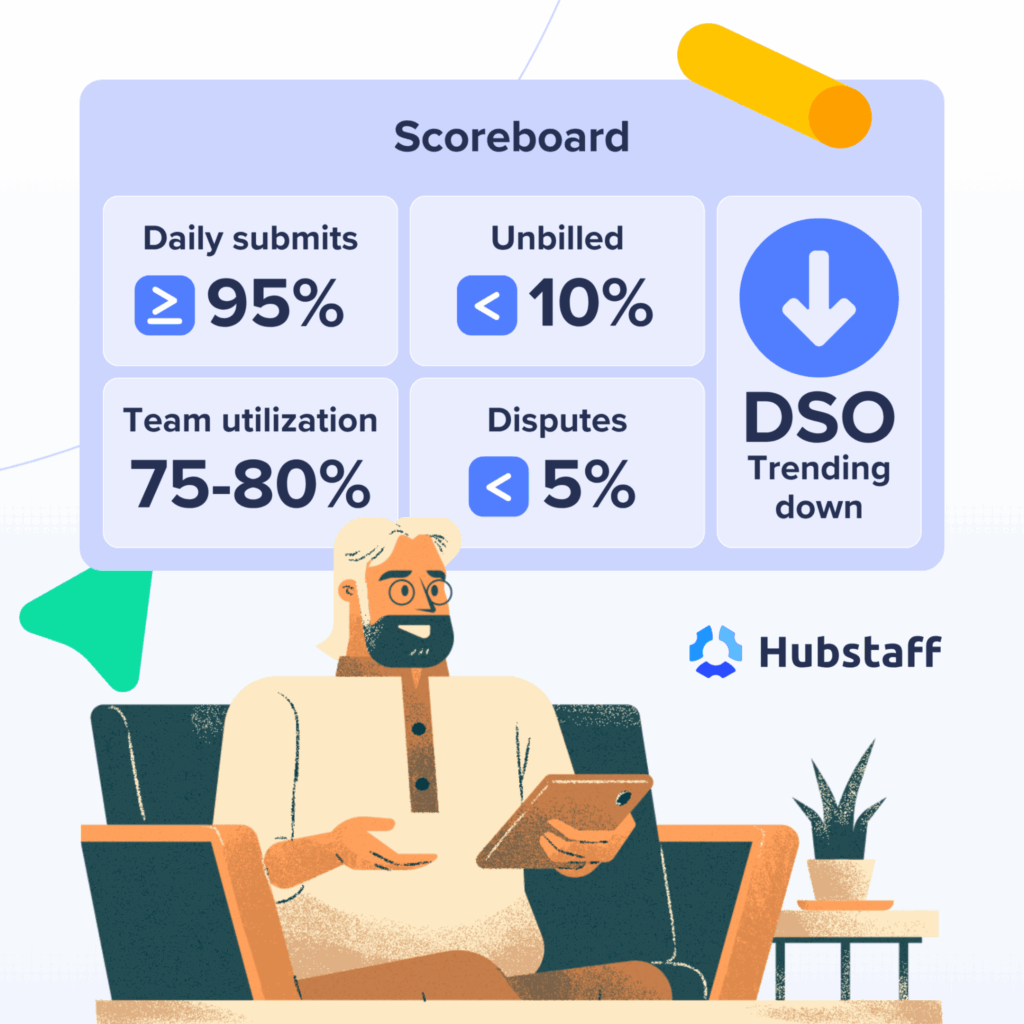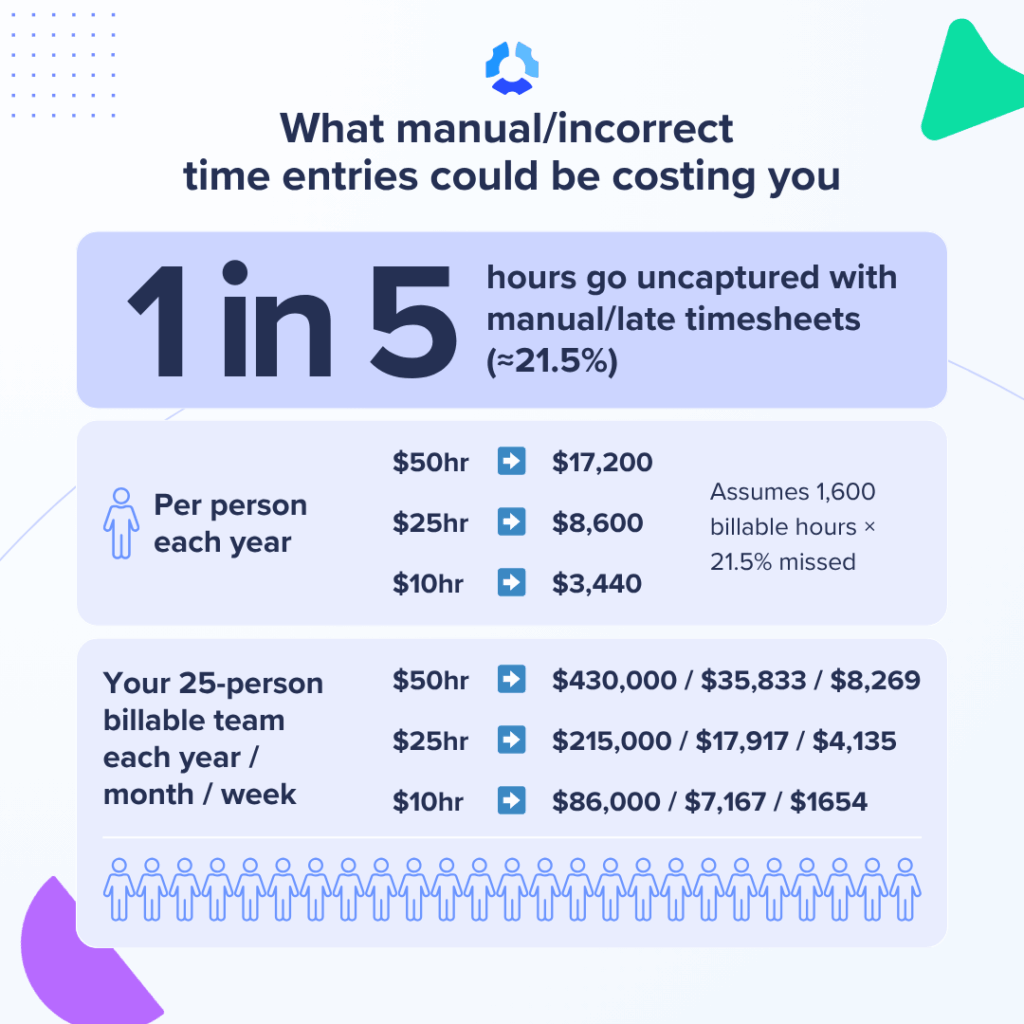Ever wondered how much time recruitment agencies waste on administrative tasks? For mid-sized teams, 1 in 5 instances of manual tracking can cost an agency up to $430,000 annually. The right recruitment agency timesheet software doesn’t just save time — it helps you scale with control.
Timesheet software not only streamlines administrative duties but also enhances overall productivity. Imagine reducing the countless hours spent on manual timesheet tracking and payroll processing. Recruitment agency timesheet software automates this process, allowing recruiters to focus on finding top talent instead of tracking billable hours.
With online timesheets, you can transform chaotic operations into a well-oiled machine. Let’s explore the best recruitment agency timesheet software that will save you time and money.
Boost your team’s efficiency with Hubstaff's productivity tools
Understanding timesheet software in recruitment
Check out our How Smart Agencies Scale report for tangible, weekly data on utilization, unbilled hours, and disputes to ensure staffing calls are data-backed.

What is timesheet software?
Timesheet software solutions are digital tools designed to track time and manage workforce operations efficiently. A timesheet tool allows employees to log their hours worked, categorize their tasks, and submit timesheets online without using manual time cards.
Online timesheet software for recruitment agencies is indispensable as it helps streamline payroll processes. This ensures that every hour worked is accurately recorded and compensated.
Key benefits for recruitment agencies
When unbilled hours go unchecked, it can get costly. In fact, the recent Hubstaff report reveals that agencies are losing up to 21.5% of billable hours due to late or incomplete timesheets—translating to $51K–$64K in lost revenue per billable employee each year.
That’s where time tracking software makes a measurable impact. It helps recruitment and staffing agencies to:
- Improve billing accuracy. With timesheet software, you can easily track billable hours to ensure that clients are billed correctly for services. This also eliminates discrepancies from manual data entry, promotes transparency, and leads to better client relationships.
- Streamline payroll processes. By automating and accurately tracking work hours, timesheet software helps ensure employees are paid accurately and on time.
- Help monitor projects. Recruitment agencies often juggle multiple projects and clients. Timesheet software enables you to monitor project progress in real-time, which helps with resource allocation and adherence to deadlines.
- Generates detailed reports. Timesheet software can generate detailed reports on various metrics, such as hours worked and employee productivity.
Recruitment agencies can significantly enhance their operational efficiency with timesheet software, leading to better client satisfaction and improved profitability.
Essential features of timesheet software for recruitment agencies
As with any other tool, you shouldn’t base your decision on time tracking software solely on the number of features it has. Instead, focus on the unique needs of your agency and consider whether the tool addresses them.
Here are some essential features that address the unique needs of staffing firms:
Automated time tracking
Automated time tracking ensures employees’ hours are logged automatically, eliminating the need for manual entry and reducing administrative overhead.
This not only saves time but also increases accuracy, which is crucial for managing employee time and maintaining payroll integrity. It also helps in tracking billable hours and project progress and provides seamless experience for both recruiters and employees.
Integration with recruitment platforms
For staffing agencies, the ability to integrate timesheet software with other recruitment platforms and project management tools is a necessity. Seamless integration ensures that all data flows smoothly between systems. This way, you can cut down on redundant admin work and enhance overall efficiency.
Integrations enable agencies to manage employee time and tasks effectively, providing a clear view of project statuses. Integration capabilities also simplify payroll management by ensuring all tracked hours are accurately reflected in payroll systems.
Custom reporting tools
According to Hubstaff’s How Smart Agencies Scale report, 53% of agencies now include reporting as part of their retainers, and 80% rely on dashboards to enhance client visibility. With nearly half of clients (49%) expecting live access to performance data, clean, timely reporting has shifted from a nice-to-have to a critical component of client service.
Custom reporting tools allow agencies to generate reports for their specific needs, helping them understand:
- Workforce performance
- Project efficiency
- Resource allocation
Customizable reports can help staffing agencies optimize operations and identify areas for improvement. By analyzing these reports, agencies can gain valuable insights that they can use to improve productivity and drive success.
Compliance and security features
Compliance with employment standards and ensuring data security are paramount for staffing agencies. Timesheet software should include robust compliance features that help agencies adhere to labor laws and regulations, thereby avoiding legal issues and maintaining fair labor practices.
Security features like secure access controls protect sensitive employee information by preventing access from unauthorized personnel. These features provide peace of mind and help agencies build trust with clients and employees.
Top timesheet software for recruitment agencies
Choosing the right time tracking solution can significantly enhance the efficiency of your recruitment agency. With various options available, it’s essential to find software that aligns with your unique needs.
Hubstaff: The all-in-one solution
Hubstaff’s time tracking platform with built-in productivity analytics for recruiting & staffing teams stands out with its comprehensive feature set. Automated, accurate time tracking helps reduce billing errors and minimizes administrative work, saving your team time and enhancing efficiency.
Hubstaff’s other key features include:
- Online timesheets. Easily log and track work hours with user-friendly online timesheets. Hubstaff can automatically process payments once timesheets are approved.
- Productivity tools. Hubstaff shows you apps and websites your team spends time on so you can identify time wasters and help employees avoid unimportant tasks. Need more in-depth metrics? Check out Hubstaff Insights.
- Automated payroll. Integrate with widely used payroll platforms like PayPal, Wise, and Gusto to pay teams on different apps directly through Hubstaff. You can trigger payments by approving auto-generated timesheets based on tracked hours. No manual computations needed.
- Online invoicing. Simplify billing with online invoicing. Create invoices, add custom line items, and deploy them right from the Hubstaff app.
- Detailed reports. Generate over 20+ detailed reports to understand employee productivity and overall time usage.
- GPS tracking. Manage recruiters in the field with GPS and geofencing features that help automate clock-ins and clock-outs for more accurate time tracking.
Hubstaff integrates with project management, communication, and accounting platforms, keeping all your technology in sync. This allows time tracking data to flow smoothly across your tech stack, facilitating better time management and streamlined operations.
Hubstaff Pricing & Plans
- Starter: $4.99 per user/month — billed annually
- Grow: $7.50 per user/month — billed annually
- Team: $10 per user/month — billed annually
- Enterprise: $25 per user/month — billed annually
Add-ons (annual pricing):
- Insights: $2.50 per user/month
- Tasks: $2.50 per user/month
- Data retention: $1.67 per user/month
- More screenshots: $2.50 per user/month
Comparison with other market leaders
Toggl Track
Toggl Track is known for its user-friendly interface and simplicity, making it an excellent choice for smaller teams. It stands out with its easy setup and intuitive design, allowing users to start tracking time almost immediately without a steep learning curve.
Pros:
- Easy-to-use interface
- Quick setup and implementation
- Free tier available with basic features
Cons:
- Limited advanced features
- Basic reporting capabilities
- No payroll capabilities
Clockify
Clockify offers robust time tracking and task management features. Thanks to its flexibility and scalability, it’s a popular choice among teams of all sizes — especially those looking for a cost-effective tool with a wide range of functionalities.
Pros:
- Free access to basic features and precise time tracking capabilities
- Detailed task management capabilities
- Unlimited users on the free plan
Cons:
- Advanced features require paid plans
- Basic integrations on the free tier
- The user interface can be overwhelming
Harvest
Harvest is notable for its billing and invoicing capabilities, making it ideal for agencies with specific finance and accounting integrations. It combines time tracking with robust expense tracking and invoicing capabilities.
Pros:
- Excellent invoicing and billing features
- Easy integration with financial systems
- Intuitive time tracking interface
Cons:
- Higher cost for advanced features
- Limited free plan
- Less focus on task management
Time Doctor

Time Doctor is a popular employee time tracking tool known for its detailed monitoring features. It is designed to help agencies maximize productivity by providing comprehensive time tracking and employee monitoring.
Pros:
- Advanced time tracking and monitoring features
- Detailed productivity reports
- Integration with various project management tools
Cons:
- Can be perceived as intrusive by employees
- Higher cost for full feature access
- Interface can be complex for new users
Implementing timesheet software in your recruitment agency
Integrating timesheet software into your recruitment agency can revolutionize your operations, from managing employee work hours to streamlining financial management.
Here are a few simple steps that’ll help you implement agency timesheet software effectively and overcome common challenges along the way.
- Identify key areas where timesheet software can improve efficiency, such as tracking employee hours and managing overtime.
- Select a desktop or online timesheet software solution that your teams can easily access from Windows, Mac, Linux, Android, or iOS.
- Look for features such as online timesheets, automated payroll, and seamless integration with your existing systems.
- Develop a detailed implementation plan. This should include timelines, resource allocation, and a communication strategy to keep all team members in the loop of the upcoming changes.
- Choose a configurable timesheet tool with role-based access to match your agency’s workflow. Customize it to manage schedules, resources, projects, and timesheets — all in one place.
- Provide training and support to help your team learn the platform, drive adoption, and help teams get the best out of the tools.
- After implementation, monitor performance, gather user feedback, and make adjustments to ensure the tool aligns with your processes.
- Regularly review the collected data to gain insights into productivity and efficiency. Utilize detailed reports to identify trends and optimize resource management.
Overcoming common challenges
Even the best timesheet software can fall short if adoption is rocky. To ensure smooth implementation, team buy-in, and long-term success, recruitment agencies need to anticipate common friction points.

Here are some clear strategies to overcome common challenges with software implementation:
Resistance to change
Employees may resist new systems. Address this by involving them early in the process, listening to their concerns, and creating a culture of trust and transparency. It’s also crucial to demonstrate the benefits of the new software, such as easier tracking of work hours and better management of overtime hours.
Training gaps
Inadequate training can lead to improper use of the software. Offer ongoing training and support to help users become comfortable and proficient with the new tool.
Technical issues
If you’re spending more time figuring out why the tool doesn’t work the way it should, then it’s a time waster. Work closely with your software provider to troubleshoot technical issues and achieve seamless integration.
Data accuracy
Accurate data entry is crucial for effective financial management and employee scheduling. Implement checks and balances to maintain data integrity and regularly review entries for accuracy.
Pricing and investment considerations
Investing in timesheet software is a significant decision for any recruitment agency. When considering it, it’s essential to conduct a thorough cost-benefit analysis. Here’s what you should consider:
- Initial costs. Evaluate the upfront costs of purchasing and implementing the software. This includes licensing fees, setup charges, and potential hardware investments.
- Operational efficiency. Timesheet software significantly improves operational efficiency by automating attendance tracking, project time logging, and payroll integration. This reduces administrative burdens and minimizes errors.
- Time savings. By automating the tracking of employee hours and project time, the software frees up valuable time for recruiters to focus on core work like talent acquisition and client management.
- Data accuracy. Accurate tracking of employee hours and project time ensures precise payroll integration and billing and reduces costly errors and discrepancies.
- ROI. Calculate the ROI by comparing the costs of the software against the benefits gained from reduced errors and enhanced productivity. Typically, the ROI becomes evident through reduced administrative costs and better resource allocation.
Understanding pricing models
Timesheet software comes with various pricing models, each catering to different needs and budgets. Understanding these models can help you choose the best option for your agency:
- Subscription-based pricing. This model involves paying a monthly or annual fee based on the number of users or features. It’s ideal for agencies that prefer predictable, ongoing expenses and scalability.
- Perpetual licensing. A one-time purchase grants lifetime access to the software. While the initial cost is higher, there are no recurring fees.
- Usage-based pricing. Costs are based on actual usage, such as the number of employee hours tracked or projects managed. This model can be cost-effective for agencies with fluctuating needs.
- Customized pricing. Some vendors offer tailored pricing based on specific requirements, such as payroll integration, advanced reporting, or additional support services.
Understanding these pricing structures can help agencies select a pricing model that aligns with their financial constraints and operational needs.
Frequently asked questions
What is the best timesheet software for staffing companies?
The best timesheet software for staffing companies depends on the specific needs and size of the agency. Hubstaff is highly recommended for its comprehensive features like automated time tracking, actionable visual reports, and several integrations. Other notable options include Clockify for its task management and Harvest for invoicing and financial integration.
How much does a timesheet app cost for a recruitment agency?
Costs vary: subscription-based pricing typically ranges from $5 to $20 per user per month, while perpetual licensing can be a few hundred dollars upfront. Freemium and usage-based models offer flexibility, with customized pricing available for specific requirements like custom feature sets or company sizes.
What features are essential in timesheet software for temporary staffing?
Essential features include automated time tracking, payroll integration, expense tracking, and actionable visual reports. These tools help analyze data, streamline HR management, and generate information for better decision-making.
Conclusion
Choosing the right timesheet software isn’t always fun, but it can transform your recruitment agency’s efficiency and productivity. With the help of these time tracking tools, you can make informed decisions and improve overall operations.
Need an all-in-one timesheet solution for your recruitment agency? Try Hubstaff. Sign up for a free trial and experience how Hubstaff can supercharge your time tracking and management processes.
Most popular
6 Signs Your Employees Can Tell They’re Being Monitored at Work
Noticing unfamiliar software, restricted access, or slower internet? These might be signs you are being monitored at work. I...
The Complete Guide to User Activity Monitoring: Tools, Benefits, and Ethics
Have you ever noticed how the conversation around monitoring tends to swing between “track everything” and “trust everyone b...
How to Choose the Right Employee Attendance Tracker for Your Team
An employee attendance tracker records time spent on the job, absences, late or abandoned shifts, and other valuable information....
Top 26 Best Cyber Monday & Black Friday SaaS Deals in 2025
26 Best Black Friday SaaS Deals in 2025 Black Friday has arrived, and if you’ve been waiting for the right time to upgrade your...




